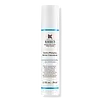What's inside
What's inside
 Key Ingredients
Key Ingredients

 Benefits
Benefits

 Concerns
Concerns

 Ingredients Side-by-side
Ingredients Side-by-side

Water
Skin ConditioningPropanediol
SolventGlycerin
HumectantIsononyl Isononanoate
EmollientButylene Glycol
HumectantPentylene Glycol
Skin ConditioningDextrin Palmitate/Ethylhexanoate
EmulsifyingLimnanthes Alba Seed Oil
Skin ConditioningHelichrysum Italicum Flower Oil
MaskingOriganum Majorana Leaf Extract
AntiseborrhoeicAcmella Oleracea Extract
Skin ProtectingHelianthus Annuus Seed Oil
EmollientAdenosine
Skin ConditioningPhenoxyethanol
PreservativeCarbomer
Emulsion StabilisingMaltodextrin
AbsorbentSodium Hydroxide
BufferingPalmitic Acid
EmollientDisodium EDTA
Cellulose Gum
Emulsion StabilisingAmodimethicone
Tocopherol
AntioxidantParfum
MaskingCI 75130
Cosmetic ColorantWater, Propanediol, Glycerin, Isononyl Isononanoate, Butylene Glycol, Pentylene Glycol, Dextrin Palmitate/Ethylhexanoate, Limnanthes Alba Seed Oil, Helichrysum Italicum Flower Oil, Origanum Majorana Leaf Extract, Acmella Oleracea Extract, Helianthus Annuus Seed Oil, Adenosine, Phenoxyethanol, Carbomer, Maltodextrin, Sodium Hydroxide, Palmitic Acid, Disodium EDTA, Cellulose Gum, Amodimethicone, Tocopherol, Parfum, CI 75130
Water
Skin ConditioningGlycerin
HumectantDimethicone
EmollientPropanediol
SolventGluconolactone
Skin ConditioningDimethicone/PEG-10/15 Crosspolymer
Polymethylsilsesquioxane
Sodium Chloride
MaskingSodium Dextran Sulfate
Gel FormingSodium Hydroxide
BufferingPhenoxyethanol
PreservativeCitric Acid
BufferingChlorphenesin
AntimicrobialSodium Citrate
BufferingP-Anisic Acid
MaskingDisodium EDTA
PEG-10 Dimethicone
Skin ConditioningAdenosine
Skin ConditioningDipropylene Glycol
HumectantTocopherol
AntioxidantWater, Glycerin, Dimethicone, Propanediol, Gluconolactone, Dimethicone/PEG-10/15 Crosspolymer, Polymethylsilsesquioxane, Sodium Chloride, Sodium Dextran Sulfate, Sodium Hydroxide, Phenoxyethanol, Citric Acid, Chlorphenesin, Sodium Citrate, P-Anisic Acid, Disodium EDTA, PEG-10 Dimethicone, Adenosine, Dipropylene Glycol, Tocopherol
 Reviews
Reviews

Ingredients Explained
These ingredients are found in both products.
Ingredients higher up in an ingredient list are typically present in a larger amount.
Adenosine is in every living organism. It is one of four components in nucleic acids that helps store our DNA.
Adenosine has many benefits when used. These benefits include hydrating the skin, smoothing skin, and reducing wrinkles. Once applied, adenosine increases collagen production. It also helps with improving firmness and tissue repair.
Studies have found adenosine may also help with wound healing.
In skincare products, Adenosine is usually derived from yeast.
Learn more about AdenosineDisodium EDTA plays a role in making products more stable by aiding other preservatives.
It is a chelating agent, meaning it neutralizes metal ions that may be found in a product.
Disodium EDTA is a salt of edetic acid and is found to be safe in cosmetic ingredients.
Learn more about Disodium EDTAGlycerin is already naturally found in your skin. It helps moisturize and protect your skin.
A study from 2016 found glycerin to be more effective as a humectant than AHAs and hyaluronic acid.
As a humectant, it helps the skin stay hydrated by pulling moisture to your skin. The low molecular weight of glycerin allows it to pull moisture into the deeper layers of your skin.
Hydrated skin improves your skin barrier; Your skin barrier helps protect against irritants and bacteria.
Glycerin has also been found to have antimicrobial and antiviral properties. Due to these properties, glycerin is often used in wound and burn treatments.
In cosmetics, glycerin is usually derived from plants such as soybean or palm. However, it can also be sourced from animals, such as tallow or animal fat.
This ingredient is organic, colorless, odorless, and non-toxic.
Glycerin is the name for this ingredient in American English. British English uses Glycerol/Glycerine.
Learn more about GlycerinPhenoxyethanol is a preservative that has germicide, antimicrobial, and aromatic properties. Studies show that phenoxyethanol can prevent microbial growth. By itself, it has a scent that is similar to that of a rose.
It's often used in formulations along with Caprylyl Glycol to preserve the shelf life of products.
Propanediol is an all-star ingredient. It softens, hydrates, and smooths the skin.
It’s often used to:
Propanediol is not likely to cause sensitivity and considered safe to use. It is derived from corn or petroleum with a clear color and no scent.
Learn more about PropanediolSodium Hydroxide is also known as lye or caustic soda. It is used to adjust the pH of products; many ingredients require a specific pH to be effective.
In small amounts, sodium hydroxide is considered safe to use. However, large amounts may cause chemical burns due to its high alkaline.
Your skin has a natural pH and acid mantle. This acid mantle helps prevent harmful bacteria from breaking through. The acid mantle also helps keep your skin hydrated.
"Alkaline" refers to a high pH level. A low pH level would be considered acidic.
Learn more about Sodium HydroxideTocopherol (also known as Vitamin E) is a common antioxidant used to help protect the skin from free-radicals and strengthen the skin barrier. It's also fat soluble - this means our skin is great at absorbing it.
Vitamin E also helps keep your natural skin lipids healthy. Your lipid skin barrier naturally consists of lipids, ceramides, and fatty acids. Vitamin E offers extra protection for your skin’s lipid barrier, keeping your skin healthy and nourished.
Another benefit is a bit of UV protection. Vitamin E helps reduce the damage caused by UVB rays. (It should not replace your sunscreen). Combining it with Vitamin C can decrease sunburned cells and hyperpigmentation after UV exposure.
You might have noticed Vitamin E + C often paired together. This is because it is great at stabilizing Vitamin C. Using the two together helps increase the effectiveness of both ingredients.
There are often claims that Vitamin E can reduce/prevent scarring, but these claims haven't been confirmed by scientific research.
Learn more about TocopherolWater. It's the most common cosmetic ingredient of all. You'll usually see it at the top of ingredient lists, meaning that it makes up the largest part of the product.
So why is it so popular? Water most often acts as a solvent - this means that it helps dissolve other ingredients into the formulation.
You'll also recognize water as that liquid we all need to stay alive. If you see this, drink a glass of water. Stay hydrated!
Learn more about Water